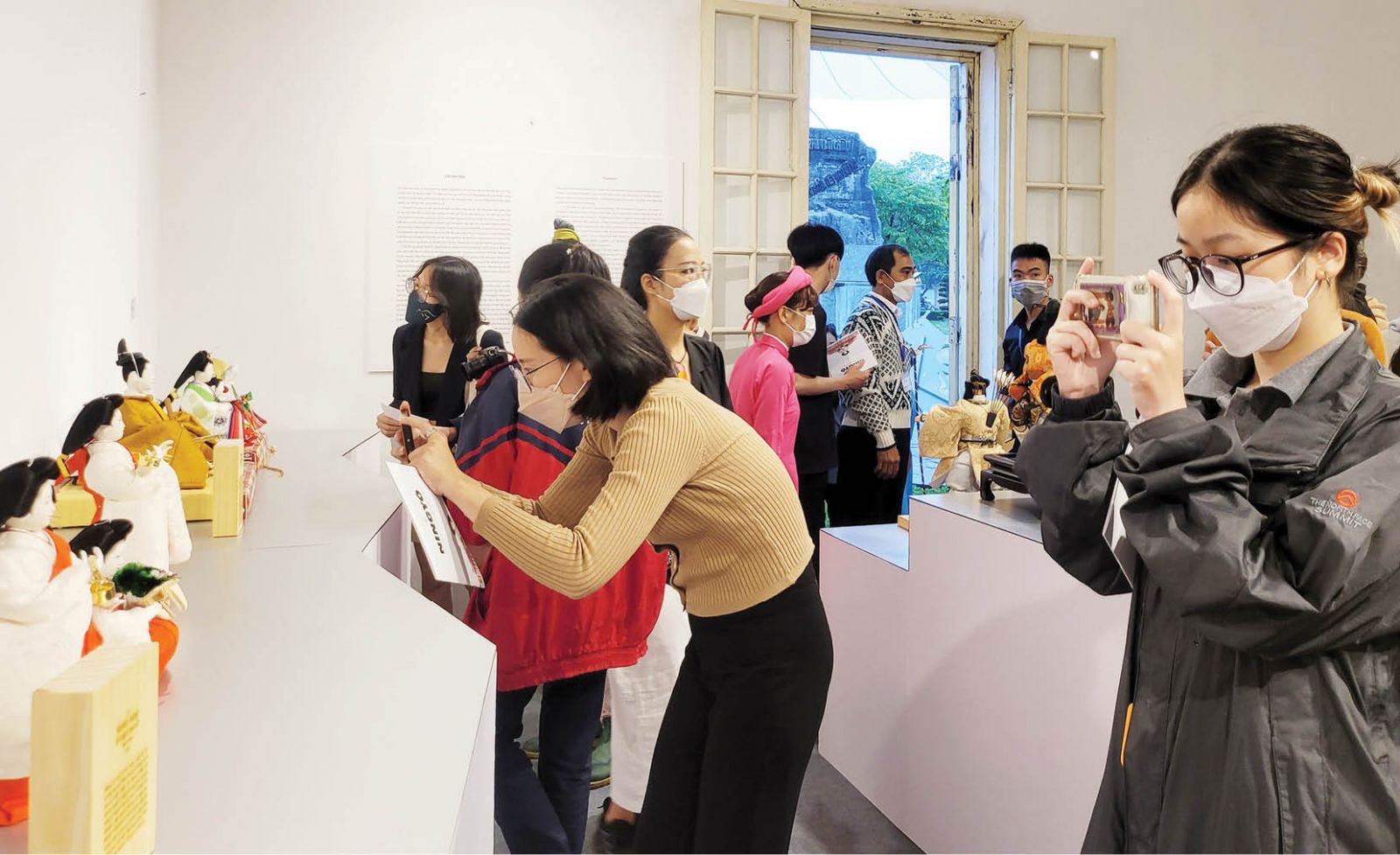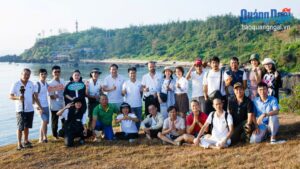From Japanese perspective, ningyo is a cultural ambassador that bring about various emotions. The making of ningyo is, therefore, a nourished traditional handicraft that displays the ingenuity of the artisan.

Exhibitions of ningyo always attracts viewers
Uniqueness and finesse
The exhibition “Ningyo – the art and beauty of Japanese dolls” at Diem Phung Thi Art Center was co-organized by Hue Museum of Fine Art and The Japan Foundation Center for Cultural Exchange in Vietnam. This is the second time Hue people have had an opportunity to admire the uniqueness and finesse of Japanese ningyo.
There are 4 sections at the exhibition: ningyo as prayers for children, ningyo as artworks, ningyo as folk art and ningyo as cultural carriers. Viewers can explore and admire the astonishing beauty of ningyo models passed on from generation to generation in Japan. Viewers also comprehend the Japanese ningyo culture, from Katashiro and Amagatsu as prototypes of Japanese ningyo, to those which reflect the climate and anecdotes. There are also dressing-up dolls that are popular in Japan today, and toy dolls and the scaled-up character dolls that are appreciated all over the world.
Taking the children to the exhibition, Nguyen Thi Hong Hoa said: “Japanese ningyo dolls are so beautiful and delicately-made. Apart from cultural values, the dolls are valuable artworks. I can learn more about the spiritual culture in Japanese life.”
Ningyo has become an essential part of everyday Japanese life since the Old Age. Ningyo reflects people’s distinctive customs, beliefs, culture and desire.
According to Ms. Ai Sugisaki, Director Assistant of The Japan Foundation Center for Cultural Exchange in Vietnam, one of the Japanese characters is a deep affection for ningyo. The culture of ningyo was flourished, especially in the 17th century, and it is present in all walks of life, both the Japanese royal and ordinary life.
A unique art of crafting
Ningyo is not a mere ornament, but it is a companion to Japanese, which can speak up the owner’s mood. This is why Japanese dolls display various nuances and gestures.
A ningyo artisan must be able to animate the doll as well as include a world of traditional culture into it. The various types of ningyo and the finesse and delicacy in crafting is fostered by a deep love for ningyo, which can be said to be the hallmarks of Japanese ningyo culture.
The crafting of traditional ningyo is rather laborious as it is all handmade. The crafting of ningyo in Japan is an art, with every stage in the process being minutely specialized.
To produce a ningyo, it requires 20-30 workers, each specializing in a particular stage of crafting, such as making heads, hair, body, limbs and glass eyes, drawing faces and designing kimonos. It takes from a few months to even a year to complete these stages.
Ms. Ai Sugisaki said that there was a particular process of crafting for each type of ningyo which also needs a particular material, such as paper, wood, clay and ceramics.
Artisans have special tools to make ningyo with different techniques and skills, such as weaving, dyeing, wood processing, lacquering and metal machining. The way they mix and match colors and the design of ningyo reflect the contemporary trends coexisting with the Japanese traditional taste. To achieve these techniques and skills, artisans need formal training.
She stressed: “Ningyo is the advanced achievement in both artistic viewpoint and modern handicraft. Japanese ningyo has been nourished via annual festivals such as Hina-matsuri and Tango-no-sekku to wish healthy development for children. Through these activities, techniques of ningyo crafting have been improved finer and finer. Many models of ningyo have been recognized in hi-tech arts, which is rare if compared with the culture of dolls in other countries in the world.”
Most of the dolls in the exhibition are Kimekomi-styled, originated from Kyoto in the 17th century. These dolls are made out of pieces of willow wood delicately wrapped with silk or brocade ribbons, showing Japanese artistic values, beliefs, spiritual power and national pride.
The folk dolls are crafted mainly from inexpensive materials such as clay, paper and wood. Japanese people often make unglazed ceramic dolls from the most common clay as the mold is already available. Some clay dolls such as Imado look attractive by their simple form; others, such as Hakata dolls, are more artistically crafted with sculpting techniques.
Miharu and Takasaki Daruma are crafted by painting on layered papers. Miharu, which is made of Japanese washi paper with subtlety in both form and character, displays traditional Kabuki actors and legendary heroes. The particularly appealing delicate colors also make this type of doll one of the most distinctive examples of paper dolls.
Japanese always show respect and love to ningyo as a living object rather than an ornament or toy. Some ningyo have been kept in family from generation to generation. Therefore, Japanese ningyo has been considered as a traditional product that they use as a gift on special occasion with the hope of prosperity and harmony.
Story and photo: Minh Hien
















